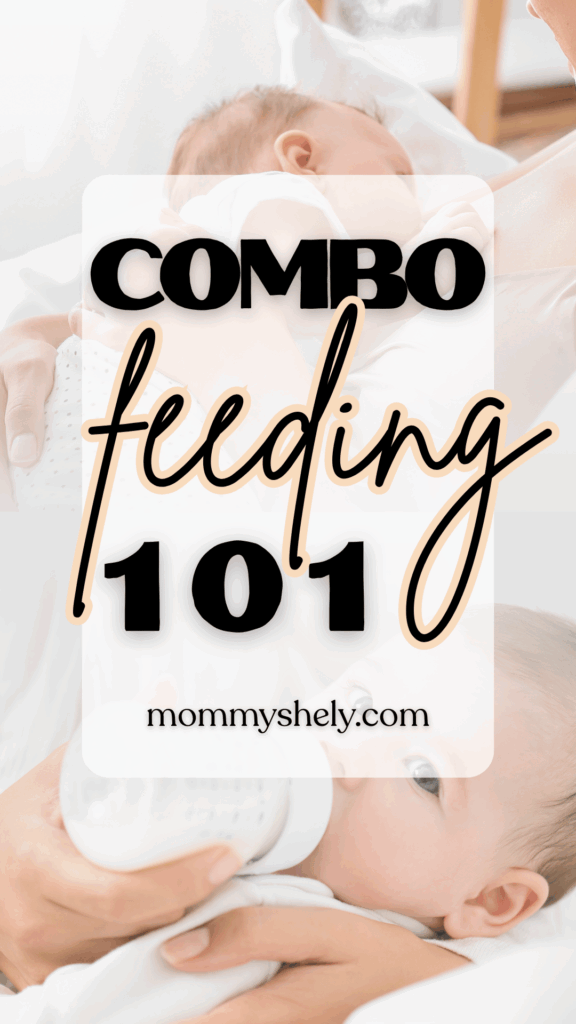If you’re feeling torn between breastfeeding and formula, or wondering if you can do both, you’re not alone.
Many parents find themselves somewhere in the middle, especially when exclusive breastfeeding feels overwhelming or unsustainable. That’s where combo feeding comes in.
Also called mixed feeding, combo feeding is when you feed your baby both breast milk and formula. It can offer flexibility, relieve pressure, and still give your baby the nourishment they need. I used this approach with my second baby, Emily, and it was honestly one of the best decisions I made during that newborn phase.
In this post, I’ll walk you through what combo feeding is, how to make it work, what challenges you might face, sample schedules, and how to find a rhythm that supports both you and your baby.
Pin For Later!

My Journey: From Exclusive Breastfeeding to Mix Feeding
I had a strong desire to exclusively breastfeed both of my babies, and fortunately, we had a promising start with excellent latching and feeding. However, both Liam and Emily were diagnosed with jaundice a day or so after birth.
With Liam, I was dead set on sticking to breastfeeding only. I was petrified of messing up his feeding routine with nipple confusion, so I kept him glued to me almost 24/7. I nursed him practically around the clock, hoping to avoid light treatment for his jaundice, and thankfully, we succeeded, though it was incredibly challenging.
With Emily, when jaundice was detected, I wasn’t as stubborn. I initially provided pumped breast milk, but when it wasn’t sufficient, and per the doctor’s strong recommendation, I introduced formula.
Surprisingly, this combo feeding baby approach proved much easier, Emily didn’t experience nipple confusion at all. We found our rhythm with both breast milk and formula. It meant I could juggle taking care of Liam while still making sure Emily was fed, calm, and content.
Understanding the challenges of baby feeding firsthand, I hope to equip you with all the essentials to navigate through this critical six-month period with ease. Ready for a crash course?
Breastfeeding, Formula, or a Mix?
First things first, deciding how you want to feed your baby is a personal choice. Each option has its own set of benefits and challenges.
- Breastfeeding offers numerous health advantages for both mother and baby, including immune system support and bonding.
- Formula feeding provides convenience and flexibility, allowing others to participate in feeding duties and giving moms a break when needed.
- Mix feeding – also known as combo feeding – lets parents combine breast milk and formula to reap the benefits of both worlds.
No matter your choice, it’s about what works for you, your baby, and your family’s needs.
What Is Combo Feeding?
Combo feeding means offering your baby both breast milk and formula. You might breastfeed during the day and offer formula at night, use formula while you’re away and breastfeed when you’re home, or alternate between breast and bottle throughout the day.
There’s no one-size-fits-all, it’s about creating a feeding style that aligns with your lifestyle and goals.
When Can You Start Combo Feeding?
Many professionals recommend waiting until breastfeeding is well established – typically around 4 to 6 weeks – before introducing bottles or formula. Especially if your goal is to breastfeed long-term. This helps reduce the risk of nipple confusion and keeps your milk supply steady.
That said, sometimes life calls for flexibility. With Emily, we started combo feeding early due to medical needs, and it worked out beautifully.
How to Introduce Formula While Breastfeeding
Introducing formula doesn’t have to be complicated. If you’re easing into combo feeding, try this:
- Start with one formula feed per day
- Offer breast first, then formula
- Choose a calm time of day
- Let someone else offer the bottle (babies often accept it more easily this way)
Remember, if your formula fed baby suddenly refuses the bottle, it’s normal. It might take trying a different nipple, temperature, or position.

How to Keep Your Milk Supply Up
One concern parents have when combo feeding a baby is milk supply. Here’s how to help maintain it:
- Breastfeed or pump frequently
- Pump when skipping nursing sessions
- Stay hydrated and nourished
- Try “power pumping” to boost supply if needed
If you’re not sure how to balance breastfeeding with pumping, I’ve written a detailed post to help you get started, Combining Breastfeeding and Pumping.
When Combo Feeding, Will My Baby Still Cluster Feed?
Yes! Even if you’re combo feeding, your baby may still cluster feed at the breast during growth spurts. This is completely normal and can actually help maintain your milk supply during these periods.
Cluster feeding typically happens around 2-3 weeks, 6 weeks, and 3 months. During these times, your baby may want to nurse more frequently for 2-3 days. Learn more about what cluster feeding looks like and how long it lasts in my complete guide to cluster feeding.
Choosing the Right Bottles for Combo Feeding
Some babies have strong preferences when switching between breast and bottle. A few tips:
- Pick slow-flow nipples designed for breastfed babies
- Use paced bottle feeding to replicate the breastfeeding rhythm
- Offer the bottle when your baby is calm
If you’re navigating this for the first time, your bottle feeding positions matter, too. Holding baby semi-upright or in a cradled side position can make the transition smoother.
With Emily, I eventually switched to glass baby bottles, and it made a real difference. They felt sturdier in my hands, cleaned up beautifully, and didn’t absorb odors or stains like plastic sometimes does. Beyond that, they’re free from harmful chemicals like BPA, making them a safer and more sustainable option.
If you’re on the fence or wondering which ones to choose, I break it all down in my post: Glass vs Plastic Baby Bottles: Which is Better for Your Baby?
Sample Combo Feeding Schedule
There’s no universal combo feeding schedule, but here’s one to get you started:
- 7:00 AM – Breastfeed
- 10:00 AM – Pumped milk or formula
- 1:00 PM – Formula
- 4:00 PM – Breastfeed
- 7:00 PM – Formula (great for partner bonding)
- 10:00 PM – Breastfeed
- 2:00 AM – Breastfeed or formula depending on baby’s needs
Stay flexible. Your routine may lean more formula-heavy or breast-heavy at different stages.
Emotional Side of Combo Feeding
Let’s talk about feelings. Many moms experience guilt or grief when exclusive breastfeeding doesn’t work out.
I know I would have felt that way with Liam if I had needed to give him formula. I was so determined to do things “by the book” that I put a lot of pressure on myself. But what I learned with Emily is that I could have made my life so much easier by being more flexible, and she still thrived.
You must remember: combo feeding isn’t giving up, it’s adjusting.
It’s finding a way to feed your baby and protect your well-being. In fact, this method can prolong your breastfeeding journey by preventing burnout.
Common Combo Feeding Challenges (and What to Do)
Baby prefers the bottle:
Try slow-flow nipples and paced bottle feeding. Offer the breast when baby is calm and relaxed.
Baby prefers the breast:
Experiment with different bottle shapes and feeding positions. Let someone else try feeding to increase acceptance.
Milk supply drops:
Pump regularly and breastfeed often. Even 1-2 sessions daily support supply.
Digestive shifts:
Switching between breast milk and formula may cause gassiness or soft stools. It usually resolves quickly.
Combo feeding can be a game-changer. It gives you the freedom to nourish your baby while also taking care of yourself.
Whether your feeding journey includes a few bottles of formula or a structured combo feeding schedule, you’re doing something wonderful.
Trust your instincts. Be kind to yourself. And remember, there’s no one right way to parent, just the one that’s right for you.
Got questions or want to share your story? I’d love to hear from you in the comments.
With love,
Shely




Thank you, Shely! We began supplementing our baby with formula on day 2. He was jaundice and seemed to not be transferring enough milk from me. I’ve dealt with guilt and disappointment and frustration over combo feeding and the fact that we’re likely going to exclusively formula-feed. Your post is encouraging. It’s nice to read the story of a mom who had a similar experience to me ❤️
Thank you so much for sharing this. I completely understand those feelings — the guilt, the frustration, and the emotional rollercoaster of combo feeding. It’s not easy when things don’t go the way we hoped, especially when it comes to something as personal as feeding our babies. You’re doing what’s best for your little one, and that takes so much strength. I’m really glad my post could offer some encouragement. ❤️